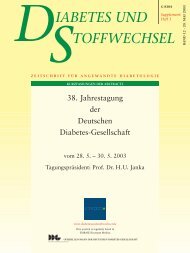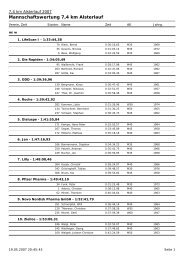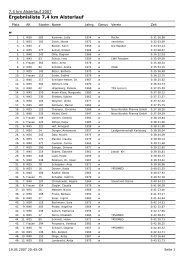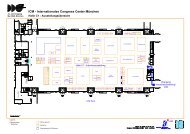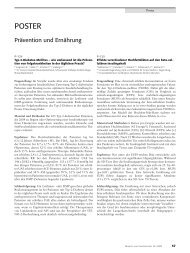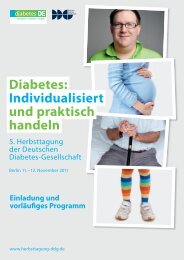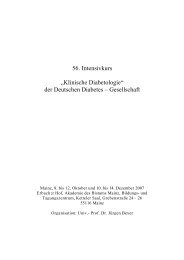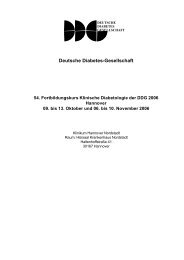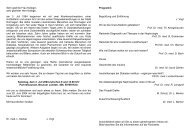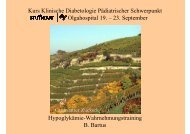Abstracts Poster - Index of
Abstracts Poster - Index of
Abstracts Poster - Index of
Sie wollen auch ein ePaper? Erhöhen Sie die Reichweite Ihrer Titel.
YUMPU macht aus Druck-PDFs automatisch weboptimierte ePaper, die Google liebt.
S52 42. Jahrestagung der Deutschen Diabetes-Gesellschaft | Hamburg, 16. – 19. Mai 2007<br />
P162<br />
TCF7L2-gene polymorphisms confer an increased<br />
risk for early impairment <strong>of</strong> glucose metabolism<br />
and increased height in obese children<br />
Körner A 1 , Kovacs P 2 , Berndt J 2 , Stumvoll M 2 , Kiess W 1<br />
1 Universität Leipzig, Klinik und Poliklinik für Kinder &<br />
Jugendliche, Leipzig, Germany, 2 Universität Leipzig,<br />
Medizinische Klinik III, Leipzig, Germany<br />
Variants in the TCF7L 2-gene have been associated with increased risk<br />
for type 2 diabetes in adults. To evaluate whether these risk variants<br />
confer a higher risk for obesity and early impairment <strong>of</strong> glucose metabolism<br />
in children, we genotyped five risk variants <strong>of</strong> the TCF7L 2-gene<br />
in a representative cohort <strong>of</strong> 1029 Caucasian children and in an independent<br />
cohort <strong>of</strong> 283 obese children. Applying a case control design,<br />
we observed a significantly lower prevalence <strong>of</strong> the rs11196205 and<br />
rs7895340 risk alleles in the obese compared to lean children (0.40 vs.<br />
0.45, P = 0.02). There was, however, no statistical significant relationship<br />
between these genotypes and quantitative traits <strong>of</strong> obesity in neither<br />
the schoolchildren nor obesity cohort. Along with the marked elevation<br />
in BMI in obese children, they were significantly taller than lean children.<br />
This increase in height was independently associated with risk<br />
variants <strong>of</strong> the TCF7L 2-gene, while in the normal representative cohort<br />
height appeared to be decreased in carriers <strong>of</strong> the minor alleles. This<br />
increase in height may be phenomenal for the constitutional (growth)<br />
acceleration frequently seen in obese children that has been discussed<br />
as potentially accelerating diabetes manifestation along with autoimmunity<br />
and insulin resistance in the accelerator hypothesis. In the obese<br />
cohort, three risk alleles (rs7901695, rs7903146, rs1225572) were significantly<br />
associated with higher fasting and stimulated blood glucose<br />
levels independent <strong>of</strong> sex, age, pubertal stage, height, and BMI. Quantitative<br />
traits <strong>of</strong> insulin secretion appeared with a similar tendency but<br />
were not statistically significant. Hence, our data indicate for the first<br />
time that TCF7L 2-gene variants confer an increased risk for early impairment<br />
<strong>of</strong> glucose metabolism in obese children, which is consistent<br />
with adult studies identifying TCF7L2 as a major diabetes susceptibility<br />
gene.<br />
P163<br />
Verminderte Serumspiegel von Adiponektin,<br />
aber keine zusätzliche Aktivierung von<br />
Entzündungsmarkern sind bei morbid adipösen<br />
Patienten mit gestörter Glukosetoleranz und Typ<br />
2 Diabetes mellitus assoziiert<br />
Schinner S 1 , Kempf K 2 , Overmann H 1 , Wertenbruch T 1 ,<br />
Rotth<strong>of</strong>f T 1 , Martin S 2 , Scherbaum WA 1 , Herder C 2<br />
1<br />
Universitätsklinik Düsseldorf, Klinik für Endokrinologie,<br />
Rheumatologie und Diabetologie, Düsseldorf, Germany,<br />
2<br />
Deutsches Diabetes Zentrum, Klinische Abteilung,<br />
Düsseldorf, Germany<br />
Fragestellung: Erhöhte Serumspiegel pro-inflammatorischer Marker<br />
und erniedrigte Adiponektinspiegel sind mit dem Auftreten von Insulinresistenz<br />
und Typ 2 Diabetes mellitus (T2DM) assoziiert. Adipositas ist<br />
der hauptsächliche Risik<strong>of</strong>aktor für die Entstehung von T2DM. Trotzdem<br />
entwickelt nur die Minderheit der Patienten sogar mit morbider Adipositas<br />
(BMI> 40 kg/m 2 ) einen Diabetes mellitus. Deshalb wurde in der<br />
vorliegenden Studie untersucht, ob morbid adipöse Patienten mit gestörter<br />
Glukosetoleranz (IGT)/Diabetes mellitus (T2DM) und solche mit<br />
normaler Glukosetoleranz (NGT) sich hinsichtlich der Serumspiegel für<br />
pro-inflammatorischer Marker und Adiponektin unterscheiden. Methoden:<br />
Insgesamt 111 Patienten (59 NGT und 52 IGT/T2DM) einer Adipositasambulanz<br />
mit morbider Adipositas (mittlerer BMI 47,3 vs.<br />
45,7 kg/m 2 ) wurden klinisch (BMI, Taillen- und Hüftumfang, Blutdruck)<br />
und laborchemisch (Cholesterin- und Triglyzeridspiegel) bezüglich metabolischer<br />
Parameter untersucht. Die Patienten wurden durch den<br />
Nüchternblutzuckerwert und einen oralen Glukosetoleranztest (oGTT)<br />
in die zwei Gruppen NGT und IGT/T2DM eingeteilt. Unterschiede bezüglich<br />
der klinischen Daten wurden mittels Mann-Whitney Test analysiert.<br />
Zudem wurden die Serumspiegel für IL-6, IL-18, TGF-beta, MCP-1, MIP-<br />
1alpha, IL-8, IP-10, RANTES und Adiponektin mittels ELISA und Luminex-<br />
Technologie gemessen. Es wurden Unterschiede zwischen NGT-Personen<br />
und Personen mit IGT bzw. T2DM mittels multipler linearer Regression<br />
basierend auf den logarithmierten Werten der Entzündungsmarker mit<br />
Adjustierung auf Geschlecht, Alter und BMI ermittelt Ergebnisse: Die<br />
Gruppen NGT und IGT/T2DM unterschieden sich hinsichtlich der Nüchtern-Triglyzeridspiegel<br />
(134 vs. 174 mg/dl; p = 0,002) und der Serumspiegel<br />
der gamma-Glutamyl transferase (25 vs. 40 U/l; p = 0,0004). Weiterhin<br />
zeigten sich in der NGT-Gruppe höhere Serumspiegel für Adiponek-<br />
tin als in der IGT/T2DM-Gruppe (7,00 vs. 6,45 mg/ml; p = 0,039). Bei den<br />
Inflamationsmarkern zeigten sich keine signifikanten Unterschiede zwischen<br />
NGT und IGT/T2DM Schlussfolgerung: Unsere Daten zeigen signifikant<br />
niedrigere Adiponektinserumspiegel bei morbid adipösen Patienten<br />
mit gestörter Glukosetoleranz und Typ2 Diabetes mellitus verglichen<br />
mit solchen mit normaler Glukosetoleranz. Demgegenüber zeigten<br />
sich zwischen den beiden Gruppen keine signifikanten Unterschiede<br />
in Serumspiegeln für pro-inflammatorische Marker. Dies sehen wir als<br />
Ausdruck der Assoziation von Adipositas per se mit Inflammation, so<br />
dass es bei den hier untersuchten morbid adpösen Patienten zu keiner<br />
zusätzlichen Assoziation von IGT/T2DM mit Entzündungsmarkern<br />
kommt.<br />
P164<br />
Genes on rat chromosome 3 are involved in the<br />
development <strong>of</strong> obesity and sex-specific<br />
dyslipidemia: Lesson from congenic DA.WOKW<br />
rats<br />
Baguhl R 1 , Lutze P 1 , Wilke B 1 , Klöting I 1<br />
1 University <strong>of</strong> Greifswald, Medical Faculty, Laboratory<br />
Animal Science, Karlsburg, Germany<br />
Aim: WOKW rats develop a number <strong>of</strong> facets <strong>of</strong> the metabolic syndrome<br />
which is polygenetically inherited as shown by mapping <strong>of</strong> quantitative<br />
trait loci (QTLs) for single facets on different chromosomes in a cross <strong>of</strong><br />
WOKW and disease-resistant DA rats. Beside others, a QTL for total<br />
cholesterol was mapped on chromosome 3. To confirm this QTL, chromosome<br />
3 congenic DA.WOKW rats (DA.3W) were generated, genetically<br />
and phenotypically characterised. Methods: DA.3W rats were generated<br />
as speed-congenics by a cross <strong>of</strong> WOKW and DA rats using marker-aided<br />
selection. The resulting cross hybrids were repeatedly backcrossed<br />
with DA using animals which were heterozygous at loci<br />
D 3Mgh3, D 3Mit3, D3Mgh5 and were most homozygous for DA alleles<br />
at 180 background loci. After 5 backcross generations, the animals were<br />
intercrossed. Animals homozygous for WOKW alleles at the loci on<br />
chromosome 3 were selected and founded the congenic DA.3W rat<br />
strain. Founder animals were fine mapped with 37 polymorphic markers<br />
on chromosome 3. 15 males and 15 females <strong>of</strong> DA.3W, DA and WOKW<br />
were longitudinally characterised for body weight, blood glucose, serum<br />
lipids, leptin and insulin from the 8th to 32nd weeks <strong>of</strong> life. Rats were<br />
killed at 32 weeks, left and right inquinal adipose pads were removed<br />
and weighed to determine the adiposity index (AI). Results: The exchanged<br />
region on chromosome 3 amounts to 72.5 Mb and spans from<br />
position 97.5 to 170 Mb. The phenotypic data showed that the body<br />
weight <strong>of</strong> congenic DA.3W rats was significantly higher than that <strong>of</strong><br />
DA rats but, was significantly lower than that <strong>of</strong> WOKW rats. The AI<br />
was also significantly higher in DA.3W than in DA but was lower than<br />
in WOKW. In addition, DA.3W rats were characterized by significantly<br />
higher leptin and insulin values than found in parental DA rats. Fasting<br />
and non-fasting serum total cholesterols were significantly higher in<br />
female DA.3W in comparison with female DA and WOKW rats. In contrast,<br />
serum total cholesterol was comparable in DA.3W, DA and WOKW<br />
males. Conclusions: The results clearly show that WOKW genes on<br />
chromosome 3 increase body weight and AI in males and females<br />
whereas serum lipids are only increased in congenic DA.3W females.<br />
Therefore, WOKW genes on this chromosomal region are involved in<br />
the development <strong>of</strong> obesity with hyperinsulinemia and hyperleptinemia<br />
as well as <strong>of</strong> sex-specific dyslipidemia.<br />
P165<br />
Diabetologie & St<strong>of</strong>fwechsel 2007; 2: S1–S136 Georg Thieme Verlag KG Stuttgart · New York · ISSN 1861-9002<br />
Effekt der Acarbose-Behandlung im Vergleich zu<br />
Placebo auf die Leukozytenzahl vor und nach<br />
einer Testmahlzeit: The Effect <strong>of</strong> Acarbose on<br />
sub-clinical Inflammation and Immune-response<br />
in early type 2 Diabetes and risk <strong>of</strong><br />
Atherosclerosis (AI(I)DA) Studie<br />
Köhler C 1 , Schaper F 1 , Bergmann S 2 , Hanefeld M 1<br />
1 GWT-TUD, Zentrum für Klinische Studien, Dresden,<br />
Germany, 2 Institut für Klinische Chemie und<br />
Laboratoriumsmedizin, Universitätsklinik ’Carl Gustav<br />
Carus’ TU Dresden, Dresden, Germany<br />
Einleitung: In einer Reihe von Studien ist der vasoprotektive Effekt der<br />
Behandlung mit dem Alpha-Glukosidase Inhibitor Acarbose, einem oralen<br />
Antidiabetikum mit postprandialer (pp), antihyperglykämischer<br />
Wirkung, beschrieben worden. Acarbose verändert in komplexer Weise<br />
den Transport, den Abbau und Resorptionsort der aus der Nahrung<br />
stammenden Glukose im Dünndarm. Da der Dünndarm das größte Im-



